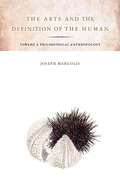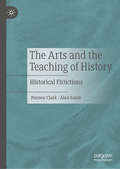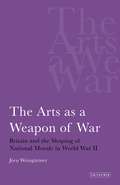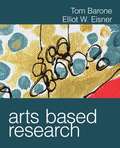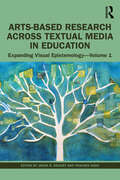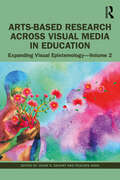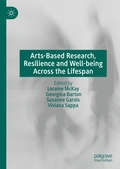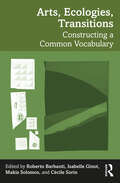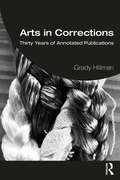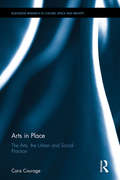- Table View
- List View
The Arts and the Definition of the Human: Toward a Philosophical Anthropology
by Joseph MargolisThe Arts and the Definition of the Human introduces a novel theory that our selves—our thoughts, perceptions, creativity, and other qualities that make us human—are determined by our place in history, and more particularly by our culture and language. Margolis rejects the idea that any concepts or truths remain fixed and objective through the flow of history and reveals that this theory of the human being (or "philosophical anthropology") as culturally determined and changing is necessary to make sense of art. He shows that a painting, sculpture, or poem cannot have a single correct interpretation because our creation and perception of art will always be mitigated by our historical and cultural contexts. Calling upon philosophers ranging from Parmenides and Plato to Kant, Hegel, and Wittgenstein, art historians from Damisch to Elkins, artists from Van Eyck to Michelangelo to Wordsworth to Duchamp, Margolis creates a philosophy of art interwoven with his philosophical anthropology which pointedly challenges prevailing views of the fine arts and the nature of personhood.
The Arts and the Teaching of History: Historical F(r)ictions
by Penney Clark Alan SearsThis book closely examines the pedagogical possibilities of integrating the arts into history curriculum at the secondary and post-secondary levels. Students encounter expressions of history every day in the form of fiction, paintings, and commemorative art, as well as other art forms. Research demonstrates it is often these more informal encounters with history that define students’ knowledge and understandings rather than the official accounts present in school curricula. This volume will provide educators with tools to bring together these parallel tracks of history education to help enrich students’ understandings and as a mechanism for students to present their own emerging historical perspectives.
The Arts as a Weapon of War: Britain and the Shaping of National Morale in World War II (International Library Of War Studies)
by Jorn WeingartnerIn 1834, Lord Melbourne spoke the words that epitomised the British government's attitude towards its own involvement in the arts: 'God help the minister that meddles with Art'. However, with the outbreak of World War II, that attitude changed dramatically when 'cultural policy' became a key element of the domestic front. Not only a propaganda tool, it aimed to boost morale and present a wartime cultural black-out. Jörn Weingärtner traces the evolution of this policy from the creation of the Committee for the Encouragement of Music and the Arts (CEMA), in 1939, to the drafting of the Arts Council's constitution in 1945, as CEMA outgrew its original wartime role. From the improvement of the National Gallery to Myra Hess's legendary concerts during the blitz, this was a crucial period in Britain's cultural history - as the government set aside its long-standing 'neutrality' towards the arts. Weingärtner engages with debate over the role of war in moulding social development, as well as the democratisation of 'high culture', to provide a fascinating account of the foundations of the modern relationship between government and the arts.
Arts-Based Educational Research and Qualitative Inquiry: Walking the Path
by Thalia M. Mulvihill Raji SwaminathanArts-Based Educational Research and Qualitative Inquiry introduces novice qualitative researchers, within education and related fields, to arts-based educational research (ABER). Abundant prompts and exercises are provided to help readers apply the concepts and experiment with various applications of the ideas presented. The authors walk the path with novice researchers offering a variety of approaches to the practice of arts-based methods, while providing a guided overview of ABER, and include pedagogical features in each chapter. Exercises are designed to assist educational researchers who wish to expand their repertoire of methodologies. The authors also weave into the discussion the possibilities and limitations of many types of arts-based methods while introducing readers to the growing methodological literature. By offering a tapestry of ways to engage the novice researcher, the book illustrates that it is not always possible to separate cognitive findings from aesthetic knowing. This book will help qualitative researchers to expand their methodologies to include arts-based approaches to their projects and by doing so reshape their identities as qualitative researchers. It also offers some evaluative criteria and tool kits for experimenting with various arts and educational research.
Arts-Based Educational Research and Qualitative Inquiry: Walking the Path
by Thalia M. Mulvihill Raji SwaminathanArts-Based Educational Research and Qualitative Inquiry introduces novice qualitative researchers, within education and related fields, to arts-based educational research (ABER). Abundant prompts and exercises are provided to help readers apply the concepts and experiment with various applications of the ideas presented. The authors walk the path with novice researchers offering a variety of approaches to the practice of arts-based methods, while providing a guided overview of ABER, and include pedagogical features in each chapter. Exercises are designed to assist educational researchers who wish to expand their repertoire of methodologies. The authors also weave into the discussion the possibilities and limitations of many types of arts-based methods while introducing readers to the growing methodological literature. By offering a tapestry of ways to engage the novice researcher, the book illustrates that it is not always possible to separate cognitive findings from aesthetic knowing. This book will help qualitative researchers to expand their methodologies to include arts-based approaches to their projects and by doing so reshape their identities as qualitative researchers. It also offers some evaluative criteria and tool kits for experimenting with various arts and educational research.
Arts-Based Methods in Refugee Research: Creating Sanctuary
by Caroline LenetteDrawn from a decade of refugee studies, this book offers a wealth of insights on arts-based methodologies. It explores exciting new prospects for participatory and culturally safe research, and will be a reference resource for researchers of all levels and community practitioners.The book tackles questions of meaningful research practice: How do people with lived experiences of forced migration—Knowledge Holders—lead the way? Can arts-based methods bring about policy and social change? And what of ethical issues?By reflecting on the strengths and limitations of four research methods (digital storytelling, photography, community music, and participatory video), readers are invited to craft their own approach to arts-based projects.
Arts Based Research
by Tom Barone Elliot W. EisnerArts Based Research is ideal for students, researchers, and practitioners. This unique book provides a framework for broadening the domain of qualitative inquiry in the social sciences by incorporating the arts as a means of better understanding and rethinking important social issues. In the book's 10 thought-provoking chapters, authors Tom Barone and Elliot W. Eisner--pioneers in the field--address key aspects of arts based research, including its purpose and fundamental ideas, controversies that surround the field and the politics and ethics involved, and key criteria for evaluation.
Arts-Based Research Across Textual Media in Education: Expanding Visual Epistemology - Volume 1
by Jason D. DeHart Peaches HashIn company with its sister volume, Arts-Based Research Across Textual Media in Education explores arts-based approaches to research across media, including film and comics-related material, from a variety of geographic locations and across a range of subdisciplines within the field of education. This first volume takes a textual focus, capturing process, poetic, and dramaturgical approaches. The authors aim to highlight some of the approaches that are not always centered in arts-based research. The contributors represent a variety of arts-based practices and methods, and they weave this marrying of artistic and scientific expertise and experience into the fabric of the chapters themselves. Authors from international contexts speak to the importance of utilizing artistic approaches for research processes. From multimodal field notes to poetic forms to the dramaturgical, chapters in this book represent steps forward in educational inquiry to bringing together both the creative and credible. The book includes multiple images and rich descriptions shared from the field. This first volume covers amongst other topics: co-created narratives, creative fiction in research, analytic portraits, dramatic representation, and critical poetic inquiry. It would be suitable for graduate students and scholars interested in qualitative inquiry and arts-based methods, in education and the social sciences.
Arts-Based Research Across Textual Media in Education: Expanding Visual Epistemology - Volume 1
In company with its sister volume, Arts-Based Research Across Textual Media in Education explores arts-based approaches to research across media, including film and comics-related material, from a variety of geographic locations and across a range of subdisciplines within the field of education. This first volume takes a textual focus, capturing process, poetic, and dramaturgical approaches. The authors aim to highlight some of the approaches that are not always centered in arts-based research. The contributors represent a variety of arts-based practices and methods, and they weave this marrying of artistic and scientific expertise and experience into the fabric of the chapters themselves. Authors from international contexts speak to the importance of utilizing artistic approaches for research processes. From multimodal field notes to poetic forms to the dramaturgical, chapters in this book represent steps forward in educational inquiry to bringing together both the creative and credible. The book includes multiple images and rich descriptions shared from the field. This first volume covers amongst other topics: co-created narratives, creative fiction in research, analytic portraits, dramatic representation, and critical poetic inquiry. It would be suitable for graduate students and scholars interested in qualitative inquiry and arts-based methods, in education and the social sciences.
Arts-Based Research Across Visual Media in Education: Expanding Visual Epistemology - Volume 2
by Jason DeHart Peaches HashIn company with its sister volume, this book explores arts-based approaches to research across media, including film and comics-related material, from a variety of geographic locations and across a range of subdisciplines within the field of education. This second volume has a focus exclusively on visual output and image-based research and methods. The book aims to highlight some of the approaches that are not always centered in arts-based research. The visual takes center stage as authors lead with comics-based representations, among other forms of arts-based inquiry. These chapters follow on from the first collection and serve to expand thinking about merging creative methods with analysis and exploration in the world of education. From mixtapes to the curatorial, these chapters showcase the ways in which scholars explore the multitude of human experiences. This second volume covers, among other topics: comics in qualitative research, visual journaling, multimodal fieldnotes and discourse, and creative visual outputs. It is suitable reading for graduate students and scholars interested in qualitative inquiry and arts-based methods, in education and the social sciences.
Arts-Based Research Across Visual Media in Education: Expanding Visual Epistemology - Volume 2
In company with its sister volume, this book explores arts-based approaches to research across media, including film and comics-related material, from a variety of geographic locations and across a range of subdisciplines within the field of education. This second volume has a focus exclusively on visual output and image-based research and methods. The book aims to highlight some of the approaches that are not always centered in arts-based research. The visual takes center stage as authors lead with comics-based representations, among other forms of arts-based inquiry. These chapters follow on from the first collection and serve to expand thinking about merging creative methods with analysis and exploration in the world of education. From mixtapes to the curatorial, these chapters showcase the ways in which scholars explore the multitude of human experiences. This second volume covers, among other topics: comics in qualitative research, visual journaling, multimodal fieldnotes and discourse, and creative visual outputs. It is suitable reading for graduate students and scholars interested in qualitative inquiry and arts-based methods, in education and the social sciences.
Arts-Based Research, Resilience and Well-being Across the Lifespan
by Susanne Garvis Georgina Barton Loraine McKay Viviana SappaThis book investigates how arts-based research methods can positively influence people’s resilience and well-being, particularly in constraining environments. Using examples from arts-based research methods in different contexts and from across the globe, the book brings together a diverse range of perspectives to understand how both resilience and well-being can be supported in a world that is rarely stress free. Collectively they demonstrate how arts-based research methods can: provide agency through the foregrounding of participants’ voices; afford transformational learning opportunities; create opportunities for relationship building; support creativity and new ways of thinking; generate aspirations and hope; encourage forms of communication that expose ideas, emotions and feelings that previously might not have been known or known how to be expressed; and enhance reflection and reflexivity. The authors explore how art-based practices, such as clowning, collage, dramatisation, drawing, painting, role-play and sculpting, can be used to support the resilience and well-being of individuals and groups across the lifespan, and theorize how arts-based research methods can positively contribute to participants’ positive self-esteem, self-image and ability to cope with challenges and new circumstances. Academics, professional learning facilitators, higher education students, and anyone interested in resilience and well-being in the health and education sectors will find this an interesting and engaging text.
Arts, Ecologies, Transitions: Constructing a Common Vocabulary
by Roberto Barbanti Isabelle Ginot Makis Solomos Cécile SorinArts, Ecologies, Transitions provides in-depth insights into how aesthetic relations and current artistic practices are fundamentally ecological and intrinsically connected to the world. As art is created in a given historic temporality, it presents specific modalities of productive and sensory relations to the world. With contributions from 49 researchers, this book tracks evolutions in the arts that demonstrate an awareness of the environmental, economic, social, and political crises. It proposes interdisciplinary approaches to art that clarify the multiple relationships between art and ecology through an exploration of key concepts such as collapsonauts, degrowth, place, recycling, and walking art. All the artistic fields are addressed from the visual arts, theatre, dance, music and sound art, cinema, and photography – including those that are rarely represented in research such as digital creation or graphic design – to showcase the diversity of artistic practices in transition.Through original research this book presents ideas in an accessible format and will be of interest to students and researchers in the fields of environmental studies, ecology, geography, cultural studies, architecture, performance studies, visual arts, cinema, music, and literature studies.
Arts, Ecologies, Transitions: Constructing a Common Vocabulary
Arts, Ecologies, Transitions provides in-depth insights into how aesthetic relations and current artistic practices are fundamentally ecological and intrinsically connected to the world. As art is created in a given historic temporality, it presents specific modalities of productive and sensory relations to the world. With contributions from 49 researchers, this book tracks evolutions in the arts that demonstrate an awareness of the environmental, economic, social, and political crises. It proposes interdisciplinary approaches to art that clarify the multiple relationships between art and ecology through an exploration of key concepts such as collapsonauts, degrowth, place, recycling, and walking art. All the artistic fields are addressed from the visual arts, theatre, dance, music and sound art, cinema, and photography – including those that are rarely represented in research such as digital creation or graphic design – to showcase the diversity of artistic practices in transition.Through original research this book presents ideas in an accessible format and will be of interest to students and researchers in the fields of environmental studies, ecology, geography, cultural studies, architecture, performance studies, visual arts, cinema, music, and literature studies.
Arts in Corrections: Thirty Years of Annotated Publications
by Grady HillmanIn Arts in Corrections, the author—a poet, translator and teacher—takes readers on a chronological journey through an annotated selection of 24 of his own publications from 1981 to 2014 which recount his experiences teaching, consulting and documenting US arts programs in prisons, jails and juvenile facilities. Anyone interested in corrections and arts-in-corrections will be drawn in by the poetic sensibility Hillman brings to his writing. Readers will gain a historical and personal perspective not only into correctional arts programming in the US over the last 40 years, but also the institutional transformations in policy, culture, populations, economics, and the criminological mission expansion into other institutional settings like K-12 education. Original essays, articles, monographs and poems are interspersed with recent annotations to deliver not only a top-down view of the correctional system but also the author’s personal journey of "discouragement and hope" from work conducted in approximately 200 adult and juvenile facilities in 30 states and six countries. This comprehensive book is essential reading for a broad cross-section of international readers interested in and involved in the arts-in-corrections field. With two million individuals behind bars in the US at any given time, the profile of arts programs in prisons and jails is rising and interest in criminal-justice matters more generally is increasing. This includes not only arts-in-corrections professionals, policy makers, students, researchers, advocates and academics, but professionals in multiple other fields as well as the general public.
Arts in Corrections: Thirty Years of Annotated Publications
by Grady HillmanIn Arts in Corrections, the author—a poet, translator and teacher—takes readers on a chronological journey through an annotated selection of 24 of his own publications from 1981 to 2014 which recount his experiences teaching, consulting and documenting US arts programs in prisons, jails and juvenile facilities. Anyone interested in corrections and arts-in-corrections will be drawn in by the poetic sensibility Hillman brings to his writing. Readers will gain a historical and personal perspective not only into correctional arts programming in the US over the last 40 years, but also the institutional transformations in policy, culture, populations, economics, and the criminological mission expansion into other institutional settings like K-12 education. Original essays, articles, monographs and poems are interspersed with recent annotations to deliver not only a top-down view of the correctional system but also the author’s personal journey of "discouragement and hope" from work conducted in approximately 200 adult and juvenile facilities in 30 states and six countries. This comprehensive book is essential reading for a broad cross-section of international readers interested in and involved in the arts-in-corrections field. With two million individuals behind bars in the US at any given time, the profile of arts programs in prisons and jails is rising and interest in criminal-justice matters more generally is increasing. This includes not only arts-in-corrections professionals, policy makers, students, researchers, advocates and academics, but professionals in multiple other fields as well as the general public.
Arts in Place: The Arts, the Urban and Social Practice (Routledge Research in Culture, Space and Identity)
by Cara CourageThis interdisciplinary book explores the role of art in placemaking in urban environments, analysing how artists and communities use arts to improve their quality of life. It explores the concept of social practice placemaking, where artists and community members are seen as equal experts in the process. Drawing on examples of local level projects from the USA and Europe, the book explores the impact of these projects on the people involved, on their relationship to the place around them, and on city policy and planning practice. Case studies include Art Tunnel Smithfield, Dublin, an outdoor art gallery and community space in an impoverished area of the city; The Drawing Shed, London, a contemporary arts practice operating in housing estates and parks in Walthamstow; and Big Car, Indianapolis, an arts organisation operating across the whole of this Midwest city. This book offers a timely contribution, bridging the gap between cultural studies and placemaking. It will be of interest to scholars, students and practitioners working in geography, urban studies, architecture, planning, sociology, cultural studies and the arts.
Arts in Place: The Arts, the Urban and Social Practice (Routledge Research in Culture, Space and Identity)
by Cara CourageThis interdisciplinary book explores the role of art in placemaking in urban environments, analysing how artists and communities use arts to improve their quality of life. It explores the concept of social practice placemaking, where artists and community members are seen as equal experts in the process. Drawing on examples of local level projects from the USA and Europe, the book explores the impact of these projects on the people involved, on their relationship to the place around them, and on city policy and planning practice. Case studies include Art Tunnel Smithfield, Dublin, an outdoor art gallery and community space in an impoverished area of the city; The Drawing Shed, London, a contemporary arts practice operating in housing estates and parks in Walthamstow; and Big Car, Indianapolis, an arts organisation operating across the whole of this Midwest city. This book offers a timely contribution, bridging the gap between cultural studies and placemaking. It will be of interest to scholars, students and practitioners working in geography, urban studies, architecture, planning, sociology, cultural studies and the arts.
The Arts in the 1970s: Cultural Closure
by Dr Bart Moore-Gilbert Bart Moore-GilbertWere the 1970s really `the devils decade'? Images of strikes, galloping inflation, rising unemployment and bitter social divisions evoke a period of unparalleled economic decline, political confrontation and social fragmentation. But how significant were the pessimism and self-doubt of the 1970s, and what was the legacy of its cultural conflicts? Covering the entire spectrum of the arts - drama, television, film, poetry, the novel, popular music, dance, cinema and the visual arts - The Arts in the 1970s challenges received perceptions of the decade as one of cultural decline. The collection breaks new ground in providing the first detailed analysis of the cultural production of the decade as a whole, providing an invaluable resource for all those involved in cultural, media and communications studies.
The Arts in the 1970s: Cultural Closure
by Dr Bart Moore-Gilbert Bart Moore-GilbertWere the 1970s really `the devils decade'? Images of strikes, galloping inflation, rising unemployment and bitter social divisions evoke a period of unparalleled economic decline, political confrontation and social fragmentation. But how significant were the pessimism and self-doubt of the 1970s, and what was the legacy of its cultural conflicts? Covering the entire spectrum of the arts - drama, television, film, poetry, the novel, popular music, dance, cinema and the visual arts - The Arts in the 1970s challenges received perceptions of the decade as one of cultural decline. The collection breaks new ground in providing the first detailed analysis of the cultural production of the decade as a whole, providing an invaluable resource for all those involved in cultural, media and communications studies.
Arts Management and Cultural Policy Research
by J. Paquette E. RedaelliThis book aims to present concepts, knowledge and institutional settings of arts management and cultural policy research. It offers a representation of arts management and cultural policy research as a field, or a complex assemblage of people, concepts, institutions, and ideas.
Arts Management, Cultural Policy, & the African Diaspora
by Antonio C. CuylerThis book centers people of African descent as cultural leaders to challenge the myth that they do not know how or care about managing and preserving their culture. Arts Management, Cultural Policy, & the African Diaspora also presents comparative case studies of the challenges, differences, similarities, and successes in approaches to cultural leadership across multiple cultural contexts throughout the diaspora. This volume disrupts the enduring and systemic global marginalization, oppression, and subjugation that threatens and undermines people of African descent’s cultural contributions to humanity. The most important distinguishing feature of the volume is its geographical use of the African diaspora to explore the subjects of arts management and cultural policy which, to date, no volume has done before. Furthermore, the volume’s comparative examination of ten critical, historical, practical, and theoretical questions makes it a significant contribution to the literatures in Arts Management, Cultural Policy, Cultural, Africana, African American, and Ethnic studies.
The Arts Management Handbook: New Directions for Students and Practitioners
by Constance DeVereaux Meg BrindleWhether the art form is theater, dance, music, festival, or the visual arts and galleries, the arts manager is the liaison between the artists and their audience. Bringing together the insights of educators and practitioners, this groundbreaker links the fields of management and organizational management with the ongoing evolution in arts management education. It especially focuses on the new directions in arts management as education and practice merge. It uses cases studies as both a pedagogical tool and an integrating device. Separate sections cover Performing and Visual Arts Management, Arts Management Education and Careers, and Arts Management: Government, Nonprofits, and Evaluation. The book also includes a chapter on grants and raising money in the arts.
The Arts Management Handbook: New Directions for Students and Practitioners
by Constance DeVereaux Meg BrindleWhether the art form is theater, dance, music, festival, or the visual arts and galleries, the arts manager is the liaison between the artists and their audience. Bringing together the insights of educators and practitioners, this groundbreaker links the fields of management and organizational management with the ongoing evolution in arts management education. It especially focuses on the new directions in arts management as education and practice merge. It uses cases studies as both a pedagogical tool and an integrating device. Separate sections cover Performing and Visual Arts Management, Arts Management Education and Careers, and Arts Management: Government, Nonprofits, and Evaluation. The book also includes a chapter on grants and raising money in the arts.
The Arts of Citizenship in African Cities: Infrastructures and Spaces of Belonging (Africa Connects)
by Mamadou Diouf Rosalind FredericksThe Arts of Citizenship in African Cities pushes the frontiers of how we understand cities and citizenship and offers new perspectives on African urbanism. Nuanced ethnographic analyses of life in an array of African cities illuminate the emergent infrastructures and spaces of belonging through which urban lives and politics are being forged.
